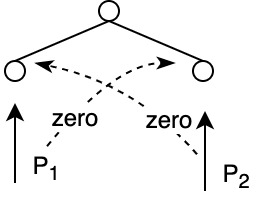8. Parallel Prefix
Feb 8, 2021
Parallel Prefix
- Given
Phase 1: perform summation then store result in leaves
Phase 2: do prefix sum: add left sibling

Phase 3: do uniprocessor prefix on chunks:

Phase 1 gives optimality, phase 2 gives speed, and phase 3 preserves optimality.
| Bounds | |
|---|---|
| phase I | |
| phase II | |
| phase III | |
| time | |
| work |
Work is optimal when
Alternative strategy: do prefix sum in phase I. In phase III add left neighbor (not sibling) to each value.
Compaction
Applications of prefix sum include: 1. processor enumeration 2. compaction: "filter a subset from a larger set" or compacts a distributed array over large range to a compact array
Example 1: Find students
Given array
Step 1. process
Step 2. run parallel prefix
Step 3. run compaction. If eligible then B[e] = student_id.
1 2 3 4 5 6 7 | |
5 eligible students remain in array
Example 2: Categorization
Categorize students by letter grade:
| Step | Explanation | Time |
|---|---|---|
| 1 | Compact A | |
| 2 | Compact B | |
| 3 | Compact C | |
| 4 | Compact D | |
| 5 | Compact F |
Overall time:
You can make this faster by looking only at 0 indices after each pass. Everything with 1 has already been processed previously (local optimization).
Notes on sorting
- Lower bound of comparison sort is
- Upper bound is
When does
If
(Are we using comparison sort here? No.)
Radix sort has different bounds: use it when
Zero Before Use
In PRAM world we have shared memory where memory is initialized to 0s. Now enumerate the processors:
- Processors that are present set their leaves to 1 then sum up the tree
- Only processors

Zero before use: assume neighbor is dead. Zero the parent of the neighbor. Then each processor sets themselves to 1. The cost of zeroing is constant: 1 operation / leaf / processor.

Memory Bootstrapping technique
Assume
Step 1. all processors clear 1 location
Step 2. use 1 processor to clear
Step 3. use
... continue until everything is clear,